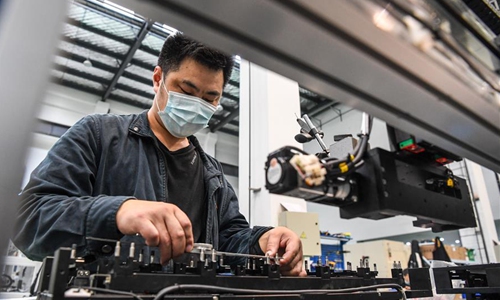China eyes 15-year R&D development plan to get ready for a tech contest with US
By Li Qiaoyi Source:Global Times Published: 2020/5/19 18:43:40

A worker assembles and tests a full-automatic picosecond laser cutting machine at Jiangsu Xianhe Laser Technology Co., Ltd. at Suqian Laser Industrial Park in Suqian City, East China's Jiangsu Province, May 14, 2020. There are over 50 laser-related companies so far in the park, among which some involves in laser cutting, laser marking and laser medical equipment. Local authorities have introduced measures to attract more laser industries to the park and support the building of a complete industry chain in laser's research and development, equipment manufacturing as well as processing and application. (Xinhua/Li Bo)
Minister of Science and Technology Wang Zhigang said Tuesday that China will draw up a 15-year roadmap for science and technology development, and he called for international cooperation in the technology sphere, despite mounting concerns over a looming tech cold war between the world's top two economies.
Future-oriented planning and the formulation of a science and technology innovation plan for the 14th Five-Year period (2021-25) are intended to improve the nation's top-level design for reform and its development of science and technology, Wang told a press conference.
The minister's comments shed light on China's painstaking indigenous innovation efforts amidst Washington's accelerating a relentless technology attack on Huawei Technologies. Chinese enterprises need to work even harder in order to move up the technology ladder and prevail in an upcoming fierce technology battle, analysts say.
China ought to face up to technological deficiencies and ramp up investment in key fields such as transistor technology, and electronic design automation tools needed by Chinese firms for chip design and verification, Bryan Wong, principle researcher at the Suning Institute of Finance in Nanjing, East China's Jiangsu Province, told the Global Times.
The US Commerce Department moved on Friday to tighten the screws on supplies to Huawei, in its bid to cut off chip supplies to Huawei. China is readying a raft of countermeasures, including putting some US companies on the "unreliable entity list".
When asked if decoupling between the two powers is inevitable, Wong, a seasoned semiconductor veteran, commented that semiconductor supply chains have matured after years of development, and accumulation of technological prowess, talent and capital. Now, China needs to draw up alternative plans including solidifying key components of the supply chain, Wong said.
The nation will craft a new round of medium to long-term plans for scientific and technological development and create a new nationwide mechanism for developing core technologies, according to a central government guideline released on Monday.
Globalized research and development of the semiconductor sector has hit its ceiling, according to the analyst at Suning Institute of Finance.
Observers believe that there have been some difficulties in obtaining core semiconductor technologies through commercial mergers and acquisitions, joint investments, and other market-driven measures.
China's research and development (R&D) spending hit 2.17 trillion yuan ($305.2 billion) in 2019, accounting for 2.19 percent of GDP, Wang disclosed at Tuesday's press event. The nation's advances in science and technology contributed to 59.5 percent of economic growth last year.
This suggests that the nation's R&D expenditure as a percentage of GDP continues at high levels. The R&D spending to GDP ratio hit a record high of 2.19 percent in 2018, up 0.04 percentage points from the year before, official data showed.
Posted in: INDUSTRIES